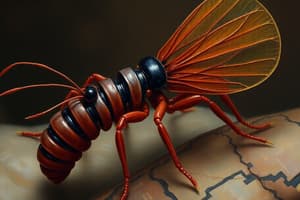Podcast
Questions and Answers
Which mode of reproduction involves the fusion of gametes to produce offspring?
Which mode of reproduction involves the fusion of gametes to produce offspring?
- Embryonic development
- Sexual reproduction (correct)
- Asexual reproduction
- Larval development
What type of development is characteristic of invertebrates like nematodes and annelids?
What type of development is characteristic of invertebrates like nematodes and annelids?
- Direct development (correct)
- Larval development
- Embryonic development
- Asexual reproduction
Which reproductive strategy involves the release of sperm into the water column?
Which reproductive strategy involves the release of sperm into the water column?
- Brooding
- Spermcasting (correct)
- Parthenogenesis
- Viviparity
What is the term for the ability of some invertebrates to produce offspring from unfertilized eggs?
What is the term for the ability of some invertebrates to produce offspring from unfertilized eggs?
Which of the following is an example of a unique reproductive feature in invertebrates?
Which of the following is an example of a unique reproductive feature in invertebrates?
What is the term for the phenomenon where males engage in competition to fertilize eggs?
What is the term for the phenomenon where males engage in competition to fertilize eggs?
Which type of development involves a larval stage that undergoes metamorphosis to become the adult form?
Which type of development involves a larval stage that undergoes metamorphosis to become the adult form?
What is the term for the reproductive strategy in which females care for their eggs and young by brooding them?
What is the term for the reproductive strategy in which females care for their eggs and young by brooding them?
Flashcards are hidden until you start studying
Study Notes
Reproduction in Invertebrates
Modes of Reproduction
- ** Sexual reproduction**: Most invertebrates reproduce sexually, involving the fusion of gametes (sperm and egg cells) to produce offspring.
- Asexual reproduction: Some invertebrates, like cnidarians and echinoderms, can reproduce asexually through budding, fragmentation, or regeneration.
Types of Development
- Embryonic development: Invertebrates like insects, arachnids, and crustaceans undergo embryonic development, where the zygote undergoes a series of cell divisions and differentiations to form a larva.
- Larval development: Many invertebrates, such as mollusks and echinoderms, have a larval stage that undergoes metamorphosis to become the adult form.
- Direct development: Some invertebrates, like nematodes and annelids, undergo direct development, where the zygote develops directly into the adult form without a larval stage.
Reproductive Strategies
- Spermcasting: Some invertebrates, like sea cucumbers and sea stars, release sperm into the water column, which then fertilize eggs released by females.
- Brooding: Some invertebrates, like corals and some mollusks, care for their eggs and young by brooding them, often in specialized structures.
- Viviparity: Some invertebrates, like some species of snails and slugs, give birth to live young, rather than laying eggs.
Unique Reproductive Features
- Hermaphroditism: Some invertebrates, like earthworms and some species of snails, are hermaphroditic, possessing both male and female reproductive organs.
- Parthenogenesis: Some invertebrates, like some species of aphids and water fleas, can reproduce parthenogenetically, where offspring develop from unfertilized eggs.
Reproductive Adaptations
- Sperm competition: In some invertebrates, like some species of beetles and flies, males engage in sperm competition, where the sperm of multiple males compete to fertilize the eggs.
- Female choice: In some invertebrates, like some species of spiders and insects, females choose their mates based on characteristics like courtship behavior or gift-giving.
Reproduction in Invertebrates
Modes of Reproduction
- Most invertebrates reproduce sexually, involving the fusion of gametes (sperm and egg cells) to produce offspring.
- Some invertebrates, like cnidarians and echinoderms, can reproduce asexually through budding, fragmentation, or regeneration.
Types of Development
- Invertebrates like insects, arachnids, and crustaceans undergo embryonic development, where the zygote undergoes a series of cell divisions and differentiations to form a larva.
- Many invertebrates, such as mollusks and echinoderms, have a larval stage that undergoes metamorphosis to become the adult form.
- Some invertebrates, like nematodes and annelids, undergo direct development, where the zygote develops directly into the adult form without a larval stage.
Reproductive Strategies
- Sea cucumbers and sea stars release sperm into the water column, which then fertilize eggs released by females.
- Corals and some mollusks care for their eggs and young by brooding them, often in specialized structures.
- Some invertebrates, like snails and slugs, give birth to live young, rather than laying eggs.
Unique Reproductive Features
- Earthworms and some species of snails are hermaphroditic, possessing both male and female reproductive organs.
- Some invertebrates, like aphids and water fleas, can reproduce parthenogenetically, where offspring develop from unfertilized eggs.
Reproductive Adaptations
- In some invertebrates, like beetles and flies, males engage in sperm competition, where the sperm of multiple males compete to fertilize the eggs.
- In some invertebrates, like spiders and insects, females choose their mates based on characteristics like courtship behavior or gift-giving.
Studying That Suits You
Use AI to generate personalized quizzes and flashcards to suit your learning preferences.




